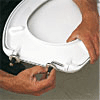
Standard lavatory cistern
There are many different styles of cisterns available on the market and on this page we will give you a simple guide of how to install your own. Low-level cisterns are mounted on the wall just above the pan, and connected to the pan with a flush pipe. Other types include high-level cisterns, which are more old-fashioned, and concealed cisterns, which are designed to be hidden behind paneling.
However the most popular are still close-coupled cisterns that sit directly on top of the pan. A standard cistern has a siphon flush mechanism operated by a ball valve and float, with a handle on the front. However, flush mechanisms do vary between designs, so always read the manufacturer’s assembly instructions.
How to Install a Close-Coupled WC
Here are some instructions for fitting a freestanding cistern with a push-button flush. This type of toilet cistern has a valve-operated flush.
- Follow the manufacturer’s instructions to assemble the flush mechanism. Make sure you include the rubber sealing rings where necessary.
- Place the flush valve mechanism into the cistern; slide the bottom threaded section through the hole in the base. Check that the rubber washer is securely on the mechanism, inside the cistern. Screw on the back nut securely, but make sure not to over tighten.
- Insert the push-button assembly through the hole in the cistern lid, and fit the nut.
- Insert the assembled inlet valve into the cistern. Make sure that the rubber washer is in place on the assembly, inside the cistern, and then lock it into position using the nut supplied. Tighten by hand and then give a further half turn using an adjustable spanner or small wrench. Do not over tighten.
- Place the large rubber gasket into the flush entrance of the pan.
- Insert the long fixing bolts through the holes in the cistern, using the rubber and large metal washers supplied.
- When lifting the cistern onto the pan, make sure the long connecting bolts fit into the provided holes in the pan. Make sure that the threaded section of the flush mechanism goes through the rubber gasket on the flush entrance of the pan.
- Fit washers to the connecting bolts, and tighten the wing nuts. Fit securely but don’t over tighten.
- Check there are no pipes or cables beneath the fixing points, then position the WC and slide the pan outlet into the flexible connector attached to the soil pipe. A little silicone grease will ease it on. Drill pilot holes into the floor at the fixing points. If it’s a solid floor you will need to drill the holes with a hammer action drill and plug them.
- Push plastic protective inserts through the holes in the base of the pan and screw the retaining screws through and into the floor. If the cistern has fixing holes in the back, fix to the wall by drilling and plugging; remember to add rubber washers before tightening the nuts.
- Connect the supply pipe for the cold water feed using a push-fit tap connector.



Step 3: Insert the push button assembly

Step 4: Insert the inlet valve assembly

Step 5: Place the gasket into the flush entrance

Step 6: Insert the fixing bolts through the holes

Step 7: Lift the cistern onto the pan

Step 8: Fit the washers to the connecting bolts

Step 9: Check there are no pipes or cables beneath the fixing points

Step 10: Push plastic protective inserts through the holes in the base

Step 11: Connect the supply pipe
Fitting the Seat
The lavatory seat and lid are fitted together, with a hinge to allow them to be raised and lowered. You can purchase new toilet seats and other accessories from the tool store below.
- Fit the hinge assembly to the seat following the manufacturer’s instructions.
- Connect the seat to the pan by securing through the holes at the back using the screws supplied. Adjust so that it sits in the correct position.

Step 1: Fit the hinge assembly

Step 2: Connect the seat to the pan

